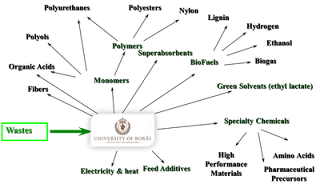There are always many talented and hard-working students. We have had several MSc students who worked well and pubished their work in scientific conferences or international scientific journals. I jused looked back in our journal publications and found many published papers, in which MSc students had great contributions. Many of those students are now Doctor or PhD students somewhere. Here is the list of these publications in which the name of those MSc students are underlined (there are also several manuscripts in publications process that are not in this list):
Journal articles (peer reviewed):
1. Modig, T., Lidén, G., and Taherzadeh, M.J. (2002): Inhibition effects of furfural on alcohol dehydrogenase, aldehyde dehydrogenase and pyruvate dehydrogenase. Biochemical J., 363(3): 769-776
2. Taherzadeh, M.J., Fox, M., Hjorth, H., Edebo, L., (2003). Cultivation of Rhizopus oryzae in synthetic medium and paper pulp sulfite liquor to produce mycelium biomass, ethanol and lactic acid. Bioresource Technol., 88(3): 167-177
3. Sues A., Millati R., Edebo L., Taherzadeh M.J. (2005): Ethanol Production from Hexoses, Pentoses, and Dilute-acid Hydrolyzates by Mucor indicus, FEMS Yeast Res., 5(6-7): 669-676
4. Arabi, R., Bemanian, S., Taherzadeh, M.J. (2007): Rapid Biodegradation of Methyl tert–Butyl Ether (MTBE) by Pure Bacterial cultures, Iran. J. Chem. Chem. Eng., 26(1): 1-7
5. Jeihanipour A., Karimi K., Taherzadeh M.J. (2007): Antimicrobial properties of fungal chitosan, Res J Biol Sci, 2(3): 239-243
6. Ebrahimi, F., Khanahmadi, M., Roodpeyma, Sh., Taherzadeh, M.J. (2008): Ethanol production from bread residues, Biomass Bioenergy, 32: 333-337
7. Sharifia, M., Karimi K., Taherzadeh M.J. (2008): Production of ethanol by filamentous and yeast-like forms of Mucor indicus from fructose, glucose, sucrose, and molasses, J. Ind. Microb. Biotechnol., 35(11): 1253-1259
8. Dehkhoda, A., Brandberg, T, Taherzadeh, M.J. (2009): Comparison of vacuum and high pressure evaporated wood hydrolyzate for ethanol production by repeated fed-batch using flocculating Saccharomyces cerevisiae, BioResources, 4(1): 309-320
9. Abedinifar, S., Karimi, K., Khanahmadi, M., Taherzadeh, M.J. (2009): Ethanol production by Mucor indicus and Rhizopus oryzae from rice straw by separate hydrolysis and fermentation, Biomass Bioenergy, 33(5): 828-833
10. Shafiei, M., Karimi, K., Taherzadeh, M.J. (2010): Pretreatment of spruce and oak by N-methylmorpholine-N-oxide (NMMO) for efficient conversion of their cellulose to ethanol, Bioresource Technol, 101(13): 4914-4918
11. Majdejabbari, S., Barghi, H., Taherzadeh. M.J. (2010): Synthesis and characterization of biosuperabsorbent based on ovalbumin protein, J. Macromol. Sci. Part A: Pure Appl. Chem., 47(7): 708-715
12. Mirahmadi, K, Kabir M.M., Jeihanipour, A., Karimi, K., Taherzadeh, M.J. (2010): Alkaline pretreatment of spruce and birch to improve bioethanol and biogas production, BioResources, 5(2): 928-938
13. Lohrasbi, M., Pourbafrani, M., Niklasson C., Taherzadeh M.J. (2010): Process design and economic analysis of a citrus waste biorefinery with biofuels and limonene as products, Bioresource Technol, 101(19): 7382-7388
14. López, Y., García, A., Karimi, K., Taherzadeh, M. J., and Martín, C. (2010): Chemical characterisation and dilute-acid hydrolysis of rice hulls from an artisan mill, BioResources 5(4), 2268-2277.
15. Bidgoli, H., Zamani, A.; Taherzadeh, M.J. (2010): Effect of carboxymethylation conditions on water binding capacity of chitosan-based superabsorbents, Carbohydrate Res., 345: 2683-2689
16. Hosseinpour, H., Karimi, K., Zilouei, H., Taherzadeh, M.J. (2010): Simultaneous pretreatment of lignocellulose and hydrolysis of starch in mixtures to sugars, BioResources, 5(4): 2457-2469
17. Shafiei, M., Karimi, K., Taherzadeh, M.J. (2010): Palm Date Fibers: Analysis and Enzymatic Hydrolysis, Int. J. Mol. Sci. 11(11), 4285-4296
18. Soudham, P.R.; Rodríguez D., Rocha G.J.M.; Taherzadeh M.J.; Martín C. (2011): Acetosolv delignification of marabou (Dichrostachys cinerea) wood with and without acid prehydrolysis, Forestry Studies in China, 13(1): 64-70
19. Akbari, H., Karimi, K., Lundin, M., Taherzadeh, M. J. (2011): Optimization of baker's yeast drying in industrial continuous fluidized-bed dryer, Food and Bioproducts Processing, in press
20. Millati, R., Wikandari, R., Trihandayani, E.T., Cahyanto, M.N., Taherzadeh M.J., and Niklasson, C. (2011): Ethanol from Oil Palm Empty Fruit Bunch via Dilute-Acid Hydrolysis and Fermentation by Mucor indicus and Saccharomyces cerevisiae, Agricultural J., 6(2): 54-59
21. Dehnavi, G.Z., Laucerica, J.L., Rodríguez, D., Beatón, M., Taherzadeh, M.J., Martin, C. (2011): Fractionation of the main components of barley spent grains from a microbrewery, Cellulose Chem. Technol, in press
22. Abtahi, Z., Millati, R., Niklasson, C., Taherzadeh, M.J. (2011): Ethanol production by Mucor indicus at high glucose and ethanol concentrations, Minerva Biotechnologica, in press
23. Jafari, V., Labafzadeh, S.R., Jeihanipour, A., Karimi, K., Taherzadeh, M.J. (2011): Construction and demolition lignocellulosic wastes to bioethanol, Renewable Energy, in press






































